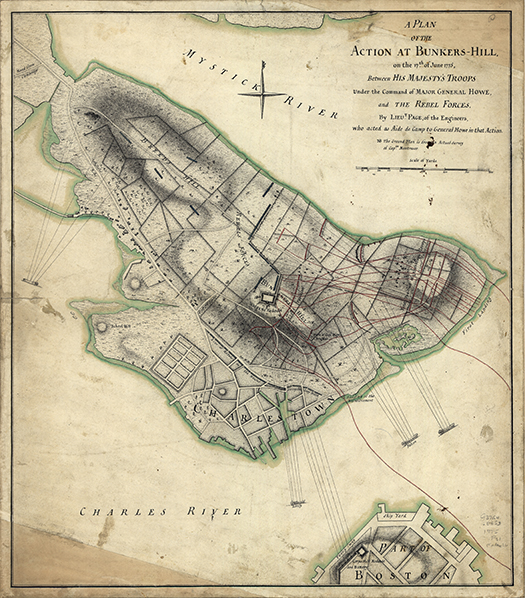

This Week in History: The Battle of Bunker Hill
The Battle of Bunker Hill
On June 17, 1775, American troops displayed their mettle in the Battle of Bunker Hill during the siege of Boston, inflicting casualties on nearly half of the British troops dispatched to secure Breed’s Hill (where most of the fighting occurred).
Battle of Bunker Hill. E. Percy Moran, artist; Photomechanical print, c1909. Prints & Photographs Division
A plan of the action at Bunkers-Hill, on the 17th. of June, 1775… Sir Thomas Hyde-Page, 1775. Military Battles and Campaigns. Geography & Map Division
Approximately 2,100 British troops under the command of General Thomas Gage stormed Breed’s Hill, where colonial soldiers were encamped. In their fourth charge up the hillside, the British took the hill from the rebels, who had run out of ammunition. After suffering more than 1,000 casualties during their attacks on Breed’s Hill, the British halted their assaults on rebel strongholds in Boston. The last rebels left on the hill evaded capture by the British thanks to the heroic efforts of Peter Salem, an African-American soldier who mortally wounded the British commanding officer who led the last charge.
When George Washington assumed command of colonial forces two weeks later, he garnered ammunition for Boston troops and secured Dorchester Heights and Bunker Hill.
Several speeches in the collection African American Perspectives: Materials Selected from the Rare Book Collection, contain references to Peter Salem, the former slave and hero of the Battle of Bunker Hill:
Mr. Everett has described Peter Salem, a black man, and once a slave, as having been among the most prominent and meritorious characters at the battle of Bunker’s Hill. Indeed, the historical painting of that scene, by Col. Trumbull, an eyewitness, done in 1785, gives Peter Salem , with other black patriots, a conspicuous place. One of the latter is thus commemorated:
“To the Honorable General Court of the Massachusetts Bay: The subscribers beg leave to report to your Honorable House (which we do in justice to the character of so brave a man), that, under our own observation, we declare that a negro man, called Salem Poor, of Col. Frye’s regiment, Capt. Ames’ company, in the late battle at Charlestown, behaved like an experienced officer, as well as an excellent soldier. To set forth particulars of his conduct would be tedious. We would beg leave to say, in the person of this said negro, centres a brave and gallant soldier. The reward due to so great and distinguished a character, we submit to the Congress.”
Cambridge, Dec. 5, 1755.“A Reading on Slavery, from the Early Presidents.” Opinions of the Early Presidents, and of the Fathers of the Republic, upon Slavery and upon Negroes as Men and Soldiers. New York: W.C. Bryant & Co., printers, 1863. African American Perspectives: Materials Selected from the Rare Book Collection. Rare Book & Special Collections Division
Boston, Mass., Birdseye View of Charlestown and Bunker Hill. [between 1890 and 1910]. Detroit Publishing Company. Prints & Photographs Division
Spirit of ’76. Billy Bitzer, camera; United States: American Mutoscope and Biograph Company, 1905. Varety Stage Sound Recordings and Motion Pictures. Motion Picture, Broadcasting & Recorded Sound Division
Learn More
- Search on Peter Salem in African American Perspectives: Materials Selected from the Rare Book Collection to find references to the former slave and hero of the Battle of Bunker Hill.
- Search the George Washington Papers for documents related to the Battle of Bunker Hill, including Washington’s estimate of British casualties at the battle.
- The Detroit Publishing Company collection contains several photos of Boston, including photos of Breed’s Hill and Bunker Hill. Search the collection on Boston.
- Search America Singing: Nineteenth Century Song Sheets on Bunker Hill for musical compositions commemorating the battle.
- Printed Ephemera: Three Centuries of Broadsides and Other Printed Ephemera contains a number of items related to the battle and subsequent monument.
- American Leaders Speak: Recordings from World War I contains a speech by Calvin Coolidge on equal rights that includes references to Revolutionary War battles, including the Battle of Bunker Hill.
- The January 28, 1795, entry in the Senate Journal includes a petition from a veteran of the Battle of Bunker Hill to be added to the list of invalid pensioners. Search on Bunker Hill in A Century of Lawmaking for a New Nation: U.S. Congressional Documents and Debates, 1774-1875 for additional petitions from men wounded at the battle.
- See the Today in History feature on artist John Trumbull whose paintings depicting the Battle of Bunker Hill and other events of the Revolutionary period have become American icons. Search the collection on revolution to find other features on the Revolutionary War.
- See the 1905 film Spirit of ’76 from the American Mutoscope and Biograph Company. The film is a dramatic recreation of Archibald Willard’s famous painting by the same title and was made to illustrate the well-known song “The Battle of Bunker Hill.”





